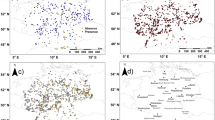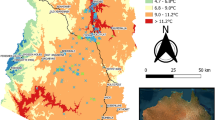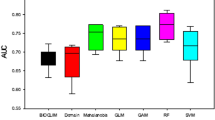Abstract
Pawpaw (Asimina triloba [L.] Dunal) is a small deciduous tree in eastern North America notable for its edible fruit. Its northern range extends into New York State (NYS) where it is listed as threatened, with only approximately 20 sites known to contain pawpaw. This research models the geographic distribution of pawpaw in western NYS (land area = 27,263 km2) for four reasons: to understand factors shaping its distribution, to assess the degree to which it is protected, to locate potential introduction or reintroduction sites, and to locate potential sites with undiscovered pawpaw. This study uses an ensemble of small models (ESM) approach devised for modeling the distribution of rare species, which averages predictions from simple (i.e., bivariate) models weighted by model predictive performance. The ESM in this study, constructed from boosted regression tree (BRT) models, demonstrated a high ability to discern pawpaw presences from pseudo-absences. The area under the receiver operating characteristic curve (AUC) value was 0.986 when calculated using training data, and BRT models comprising the ESM exhibited AUC values calculated using cross-validation data as high as 0.957. The ESM suggests that pawpaw is found in the warmest (mean annual temperature > 9.0 °C,) and driest (May–September precipitation < 44 cm) areas of western NYS, and on mildly acidic (pH = 5.5–7.0) and deep (> 110 cm) soils. Locations predicted to be suitable for pawpaw are overwhelmingly found on unprotected lands; forested areas in PAs with “high” or “highest” suitability for pawpaw only comprise 0.1–0.2% of the study area.






Similar content being viewed by others
Data availability
Restrictions apply to the availability of data, since pawpaw is a threatened species in NYS and its locations are kept confidential.
Code availability
R code created for this study are available upon request from the author.
References
Barlow C (2000) The ghosts of evolution nonsensical fruit, missing partners, and other ecological anachronisms. Basic Books, New York
Bosso L, Smeraldo S, Rapuzzi P, Sama G, Garonna AP, Russo D (2017) Nature protection areas of Europe are insufficient to preserve the threatened beetle Rosalia alpina (Coleoptera: Cerambycidae): evidence from species distribution models and conservation gap analysis. Ecol Entomol 43:192–203
Bowden WM, Miller B (1951) Distribution of the papaw, Asimina triloba (L.) Dunal, in southern Ontario. Can Field-Nat 65:27–31
Breiner FT, Guisan A, Bergamini A, Nobis MP (2015) Overcoming limitations of modelling rare species by using ensembles of small models. J Anim Ecol 6:1210–1218
Breiner FT, Nobis MP, Bergamini A, Guisan A (2018) Optimizing ensembles of small models for predicting the distribution of species with few occurrences. Methods Ecol Evol 9:802–808
Callaway MB (1990) The pawpaw. Kentucky State University, Frankfort, KY USA
Catullo G, Masi M, Falcucci A, Maiorano L, Rondinini C, Boitani L (2008) A gap analysis of Southeast Asian mammals based on habitat suitability models. Biol Cons 141:2730–2744
Damman H, Feeny P (1988) Mechanisms and consequences of selective oviposition by the zebra swallowtail butterfly. Anim Behav 36:563–573
Di Musciano M, Di Cecco V, Bartolucci F, Conti F, Frattaroli AR, Di Martino L (2020) Dispersal ability of threatened species affects future distributions. Plant Ecol 221:265–281
Elith J, Leathwick JR, Hastie T (2008) A working guide to boosted regression trees. J Anim Ecol 77:802–813
Engelbrecht W (2003) Iroquoia: the development of a native world. Syracuse University Press, Syracuse
Esri (2019) ArcGIS Pro 2.4. Redlands
Fawcett T (2006) An introduction to ROC analysis. Pattern Recognit Lett 27:861–874
Fenneman NM (1938) Physiography of eastern United States. McGraw-Hill Book Company, New York
Franklin J, Miller JA (2009) Mapping species distributions: spatial inference and prediction. Cambridge University Press, New York
Hijmans RJ, Phillips S, Leathwick J, Elith J (2013) Dismo: species distribution modeling. R package version 0.8–17.
Homer C, Dewitz J, Jin S, Xian G, Costello C, Danielson P, Gass L, Funk M, Wickham J, Stehman S, Auch R, Riitters K (2020) Conterminous United States land cover change patterns 2001–2016 from the 2016 national land cover database. ISPRS J Photogramm Remote Sens 162:184–199
Hosaka N, Gómez S, Kachi N, Stuefer JF, Whigham DF (2005) The ecological significance of clonal growth in the understory tree, pawpaw (Asimina triloba). Northeastern Naturalist 12:11–12
House HD (1918) Report of the State Botanist 1917. The University of the State of New York, Albany
Immel DL, Anderson MK (2001) PAWPAW: Asimina triloba (L.) Dunal. USDA NRCS National Plant Data Center
Jaberalansar Z, Tarkesh M, Bassiri M (2018) Spatial downscaling of climate variables using three statistical methods in Central Iran. J Mt Sci 15:606–617
Jones SC, Peterson RN, Turner T-A, Pomper KW, Layne DR (2019) Pawpaw planting guide. Kentucky State University. https://kysu.edu/academics/cafsss/pawpaw/pawpaw-planting-guide/
Keener C, Kuhns E (1997) The impact of Iroquoian populations on the northern distribution of pawpaws in the northeast. North Am Archaeol 18:326–342
Kimmerer R (2011) Restoration and reciprocity: the contributions of traditional ecological knowledge. In: Egan D, Hjerpe EE, Abrams J (eds) Human dimensions of ecological restoration: integrating science, nature, and culture. Island Press, Washington, pp 257–276
Kreger M, Schmidt P (2011) The state of the birds 2011: report on public lands and waters. Diane Publishing Co, Darby
Larimore RL, Busemeyer DT, Ebinger JE (2003) Pawpaw, Asimina triloba (L.) Dunal (Annonaceae), in the Prairie Peninsula of Illinois, USA. Nat Areas J 23:356–361
Little EL, Viereck LA (1971) Atlas of United States trees. United States Department of Agriculture, Washington
McLaughlin JL (2008) Paw paw and cancer: Annonaceous acetogenins from discovery to commercial products. J Nat Prod 71:1311–1321
Murphy JL (2001) Pawpaws, persimmons, and ’possums: on the natural distribution of pawpaws in the northeast. North Am Archaeol 22:93–115
Natural Resources Conservation Service (2014) Description of SSURGO database. https://www.nrcs.usda.gov/wps/portal/nrcs/detail/soils/survey/?cid=nrcs142p2_053627
NatureServe (2020) Asimina triloba: pawpaw. NatureServe Explorer. https://explorer.natureserve.org/Taxon/ELEMENT_GLOBAL.2.148616/Asimina_triloba. Accessed on 31 Mar 2020
Nowacki GJ, Abrams MD (2008) The demise of fire and “mesophication” of forests in the Eastern United States. Bioscience 58:123–138
NYNHP (2019) Element occurrence dataset. SUNY College of Environmental Science and Forestry, Albany
Parker AC (1910) Iroquois uses of maize and other food plants. University of the State of New York, Albany
Parker AC (1920) The archeological history of New York. The University of the State of New York, Albany
Phillips SJ, Dudik M (2008) Modeling of species distributions with Maxent: new extensions and a comprehensive evaluation. Ecography 31:161–175
Prasad AM, Iverson LR, Matthews S, Peters M (2007) Climate change tree atlas (a spatial database of 134 tree species of the Eastern USA). U.S. Forest Service Northern Research Station. https://www.nrs.fs.fed.us/atlas/tree/#
PRISM Climate Group (2013) Gridded climate data for the contiguous USA. https://www.prism.oregonstate.edu/
Pursh F (1869) Journal of a botanical excursion in the northeastern parts of the states of Pennsylvania and New York, during the year 1807. Brinckloe & Marot, Philadelphia
R Core Team (2018) R: a language and environment for statistical computing. R Foundation for Statistical Computing, Vienna
Slater MA, Anderson RC (2014) Intensive selective deer browsing favors success of Asimina triloba (paw paw) a native tree species. Natural Areas Journal 34:178–187
Snow DR (1996) The Iroquois. Blackwell Publishers Inc, Malden
Sullivan J (1993) SPECIES: Asimina triloba. Fire Effects Information System (FEIS), U.S. Department of Agriculture, Forest Service, Rocky Mountain Research Station, Fire Sciences Laboratory (Producer). https://www.fs.fed.us/database/feis/plants/tree/asitri/all.html
Swets JA (1988) Measuring the accuracy of diagnostic systems. Science 240:1285–1293
Tulowiecki SJ (2020) Modeling the historical distribution of American chestnut (Castanea dentata) for potential restoration in western New York State. US For Ecol Manage 462:118003
Tulowiecki SJ, Larsen CPS (2015) Native American impact on past forest composition inferred from species distribution models, Chautauqua County, New York. Ecol Monogr 85:557–581
Tulowiecki SJ, Larsen CPS, Wang Y-C (2015) Effects of positional error on modeling species distributions: a perspective using presettlement land survey records. Plant Ecol 216:67–85
Tulowiecki SJ, Robertson DS, Larsen CPS (2020) Oak savannas in western New York State, circa 1795: synthesizing predictive spatial models and historical accounts to understand environmental and native American influences. Ann Am Assoc Geogr 110:184–204
USGS (2013) The national map viewer and download platform. https://nationalmap.gov/viewer.html
USGS (2017) National Hydrography Dataset Best Resolution. https://www.usgs.gov/core-science-systems/ngp/national-hydrography
USGS (2020) TopoView. https://ngmdb.usgs.gov/topoview/. Accessed 22 Apr 2020
USGS Gap Analysis Project (2018) PAD-US Data Download. In: Protected Areas Database of the United States (PAD-US). https://www.usgs.gov/core-science-systems/science-analytics-and-synthesis/gap/science/pad-us-data-download?qt-science_center_objects=0#qt-science_center_objects
Waugh FW (1916) Iroquis [sic] foods and food preparation. Government Printing Bureau, Ottawa
Williams JN, Seo C, Thorne J, Nelson JK, Erwin S, O’Brien JM, Schwartz MW (2009) Using species distribution models to predict new occurrences for rare plants. Divers Distrib 15:565–576
Willson MF, Schemske DW (1980) Pollinator limitation, fruit production, and floral display in pawpaw (Asimina triloba). Bull Torrey Bot Club 107:401–408
Young SM (2019) New York rare plant status lists. New York Natural Heritage Program, New York State Department of Environmental Conservation, Albany
Author information
Authors and Affiliations
Corresponding author
Additional information
Communicated by Hsiao-Hsuan Wang.
Publisher's Note
Springer Nature remains neutral with regard to jurisdictional claims in published maps and institutional affiliations.
Rights and permissions
About this article
Cite this article
Tulowiecki, S.J. Modeling the geographic distribution of pawpaw (Asimina triloba [L.] Dunal) in a portion of its northern range limits, western New York State, USA. Plant Ecol 222, 193–208 (2021). https://doi.org/10.1007/s11258-020-01098-x
Received:
Accepted:
Published:
Issue Date:
DOI: https://doi.org/10.1007/s11258-020-01098-x




